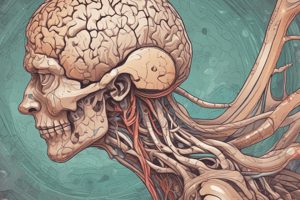Podcast
Questions and Answers
What is one of the primary functions of the frontal lobe in the cerebral cortex?
What is one of the primary functions of the frontal lobe in the cerebral cortex?
- Visual processing
- Auditory processing
- Executive functions (correct)
- Spatial orientation
Which neurotransmitter is primarily associated with mood regulation and feelings of happiness?
Which neurotransmitter is primarily associated with mood regulation and feelings of happiness?
- Serotonin (correct)
- GABA
- Norepinephrine
- Dopamine
Which hemisphere of the brain is typically dominant for language tasks?
Which hemisphere of the brain is typically dominant for language tasks?
- Left Hemisphere (correct)
- Both Hemispheres equally
- Either Hemisphere based on individual differences
- Right Hemisphere
What is the role of the corpus callosum in the brain?
What is the role of the corpus callosum in the brain?
Which of the following neurotransmitters is known to help with muscle activation and learning?
Which of the following neurotransmitters is known to help with muscle activation and learning?
What cognitive functions are prominently facilitated by the cerebral cortex?
What cognitive functions are prominently facilitated by the cerebral cortex?
Which task is the right hemisphere of the brain mainly responsible for?
Which task is the right hemisphere of the brain mainly responsible for?
Which neurotransmitter is considered the main inhibitory neurotransmitter in the brain?
Which neurotransmitter is considered the main inhibitory neurotransmitter in the brain?
Flashcards are hidden until you start studying
Study Notes
Human Nervous System Study Notes
Cerebral Cortex Functions
- Structure: Outer layer of the brain, composed of gray matter.
- Functions:
- Sensory Processing: Interprets sensory information (e.g., vision, hearing, touch).
- Motor Control: Plans and executes voluntary movements.
- Cognitive Functions: Involved in thinking, reasoning, problem-solving, and decision-making.
- Language: Facilitates understanding and production of language (primarily in the left hemisphere).
- Memory: Plays a role in storing and retrieving memories.
- Regions:
- Frontal Lobe: Executive functions, decision making, personality.
- Parietal Lobe: Sensory perception, spatial orientation.
- Temporal Lobe: Auditory processing, memory, language comprehension.
- Occipital Lobe: Visual processing.
Brain Hemispheres
- Left Hemisphere:
- Controls right side of the body.
- Dominant for language and analytical tasks.
- Associated with logical reasoning and mathematical skills.
- Right Hemisphere:
- Controls left side of the body.
- Involved in creative tasks and holistic thought.
- Associated with spatial abilities, face recognition, and emotional processing.
- Corpus Callosum: Thick band of nerve fibers connecting the two hemispheres, facilitating communication between them.
Neurotransmitter Roles
- Definition: Chemical messengers that transmit signals across synapses between neurons.
- Key Neurotransmitters:
- Dopamine: Influences mood, motivation, and reward; associated with movement and addiction.
- Serotonin: Regulates mood, appetite, and sleep; linked to feelings of happiness.
- Norepinephrine: Involved in arousal, alertness, and stress response; affects attention and response actions.
- Acetylcholine: Important for muscle activation, memory, and learning.
- GABA (Gamma-Aminobutyric Acid): Main inhibitory neurotransmitter, reduces neuronal excitability, calms the nervous system.
- Glutamate: Main excitatory neurotransmitter, essential for synaptic plasticity and learning.
- Functionality: Neurotransmitters bind to specific receptors on neurons, influencing their activity and communication.
Cerebral Cortex Functions
- Structure: The cerebral cortex is the outer layer of the brain, primarily composed of gray matter.
- Sensory Processing: Responsible for interpreting sensory information such as vision, hearing, and touch.
- Motor Control: Plans and executes voluntary muscle movements.
- Cognitive Functions: Engages in higher-level processes like thinking, reasoning, and problem-solving.
- Language: Primarily located in the left hemisphere, it facilitates the understanding and production of language.
- Memory: Involved in both the storage and retrieval of memories.
- Key Regions:
- Frontal Lobe: Associated with executive functions, decision-making, and personality traits.
- Parietal Lobe: Handles sensory perception and spatial orientation.
- Temporal Lobe: Crucial for auditory processing and language comprehension, also plays a role in memory.
- Occipital Lobe: Specializes in visual processing.
Brain Hemispheres
- Left Hemisphere:
- Controls the right side of the body.
- Dominant in language processing and analytical tasks.
- Known for logical reasoning and proficiency in mathematical skills.
- Right Hemisphere:
- Governs the left side of the body.
- Engaged in creative tasks and holistic thinking.
- Contributes to spatial abilities, face recognition, and emotional processing.
- Corpus Callosum: A thick bundle of nerve fibers connecting the hemispheres, facilitating inter-hemispheric communication.
Neurotransmitter Roles
- Definition: Neurotransmitters are chemical messengers that transmit signals across synapses between neurons.
- Key Neurotransmitters:
- Dopamine: Plays a role in mood regulation, motivation, reward mechanisms, and is linked to movement and addiction.
- Serotonin: Influences mood, appetite, and sleep, and is associated with feelings of well-being and happiness.
- Norepinephrine: Affects arousal, alertness, and the body's stress response, impacting attention and reaction times.
- Acetylcholine: Vital for activating muscles and essential for memory formation and learning processes.
- GABA: Acts as the primary inhibitory neurotransmitter, reducing neuronal excitability and calming the nervous system.
- Glutamate: The main excitatory neurotransmitter, crucial for synaptic plasticity and learning capabilities.
- Functionality: Neurotransmitters interact with specific receptors on neurons, modifying their activity and enhancing communication between them.
Studying That Suits You
Use AI to generate personalized quizzes and flashcards to suit your learning preferences.



